Thailand, Part 6: Moonmuang, His-n-Hers Temples, and The Worst Mood Music I’ve Ever Heard
Hey everyone, lots of photos in today’s post. In Chaing Mai, many of the activities turned out to be sightseeing. And it’s a great place for that, let me tell you.
The trip into Chiang Mai was pretty luxurious. All accounted for, there were maybe seven passengers aboard. So of course, the bus needed a crew of three to keep things running smoothly: a driver, a conductor (or captain, maybe?), and a stewardess. We spent most of the trip flipping through the Lonely Planet guide for recommendations on accommodations, which was particularly important since we wouldn’t be arriving in town until after 10 pm.
At one point, the bus was stopped at a checkpoint at the provincial border. We were surprised when two Thai soldiers boarded the bus and checked our tickets and passports. Rachel explained that refugees in Thailand, such as members of the Hill Tribes, were not allowed to cross provincial borders without proper authorization. Satisfied that no one was trying to smuggle themselves into Chiang Mai province, the soldiers left us and we went on our way.
We arrived feeling a little disoriented (well, I was at least….it certainly didn’t help that it was nighttime and I was forced to fumble around again in sunglasses, and Thai streets aren’t exactly well-lit). We called a few guesthouses only to find that our first, second, third, and fourth choices were full. We finally found a place to stay by process of elimination, paid way too much for a songthaew ride, and were dropped off in an alleyway in the middle of the Old City of Chiang Mai.
Chiang Mai is Thailand’s second largest city, and it’s a lot like Bangkok in appearance, feeling, and smell, with subtle differences here and there (especially size, at 200,000 people). In 1292, King Mengrai chose Chiang Mai as the new capital of Lanna Kingdom, so there’s a lot of history there, including some of the oldest operational wats in Thailand. Early in its history, the city was enclosed by an extensive square rampart and a wide moat, and then it continued to grow outside the walls. The walled city came to be known as the “Old City” and the areas outside of the walls was known as the “New City.” Much of the wall has disappeared over the centuries, but the moat still divides these two parts of town, and although there are old and significant sites in both parts of Chiang Mai, the Old City still seems to be higher regarded.
Our guesthouse, the Golden Fern, was pretty basic, without a lot to recommend it except that it was clean, cheap, and air conditioned. We treated ourselves to a few bottles of Singha and called it an early night.

The next morning, we scavenged for some breakfast and found, much to our surprise, that Chiang Mai is the coffee capital of Thailand. We found a nice French-style café and had some delicious Montreal-style bagels and eggs. Then we went on two more missions: first to find a trek for the next day to Doi Inthanon National Park, second, and more importantly, to find me a new pair of glasses so I wouldn’t be Captain No-Fun as soon as nighttime hits. We found a decent place along Moonmuang Street (although it was no LensCrafters, to be sure) close to one of the last remaining gates of the wall, and I managed to find a pair that suited me for a paltry $45. Sweeeeet. I’m still wearing them today.
We spent the rest of the morning at Wats. We started out at Wat Phra Sing, the largest in Chiang Mai. I took a lot of photos there.
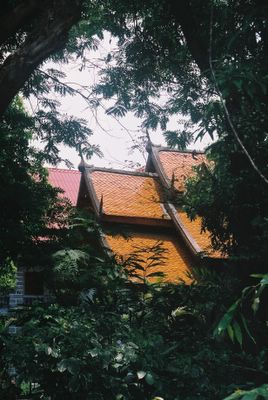
Phra Sing has been in steady operation since 1345. Lanna King Kham Fu’s ashes were interred here, but we didn’t really see much mention of this.
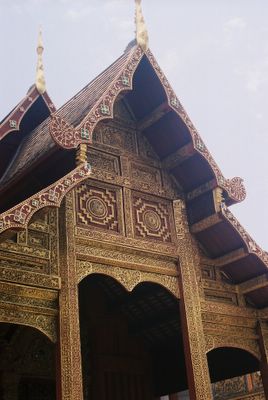
Really, the photos speak for themselves. It was an island of peace in a busy city.
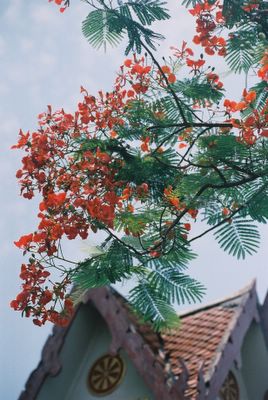
From there, we hadn’t had our fill of wats yet, so we made our way down twisting alleyways (only getting lost or confused once or twice) to Wat Chedi Luang, which was even older than Phra Sing. And you can see that the style is very different from other wats we saw, as well. We took lots of pics here, too.

Chedi Luang has had a particularly violent history. In 1317, the Lanna King Mengrai was killed here by lightning. And the main chedi of the wat, which looks kind of like a Mayan pyramid today, was severely damaged in an earthquake in 1465 and was not rebuilt.

It used to be an astonishing 90 meters high (that’s like a 20-storey building, folks). Compare this to the imposing 79 meter tower of Wat Arun (Temple of the Dawn) in Bangkok that I told you about. Chedi Luang must have stuck out from medieval Chiang Mai like the CN Tower does today in Toronto’s skyline.

From there, we made our way to an amazing place, the Warorot Market in the New City. Unlike many of the other markets we had been to, Warorot was one half grocery store and one half department store divided into hundreds of individual stalls. It was mostly aimed at residents rather than tourists and it was interesting to compare the two kinds of markets. The big food item here was pork rinds – they were literally everywhere, they’re big money in Chiang Mai and many of their local dishes include them. I’m not a huge fan, but when in Chiang Mai, y’know…
We ate lunch at the market in one of the most different and alien food courts I’ve ever experienced (again, because it was aimed at the locals instead of tourists). For the first time in Thailand, we were eating out and there wasn’t a single word of English in sight. Rachel came to the rescue once again, and I tried some serious pork noodle soup. We also had fun with the condiments that are served at the table on large trays with the meal. I couldn’t identify half of the stuff that I was adding to my soup, but it was all pretty tasty.
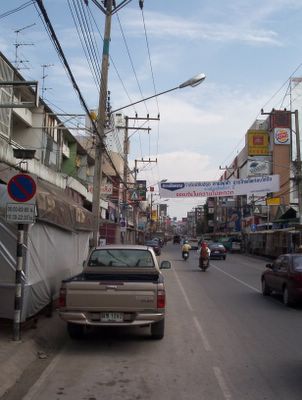
The rest of the afternoon involved wandering, shopping, and finding a better guesthouse for the next night. We also found this little gem…I’m not sure who did their translating for them, but somebody should tell them that they’ve got this wrong, so very wrong.
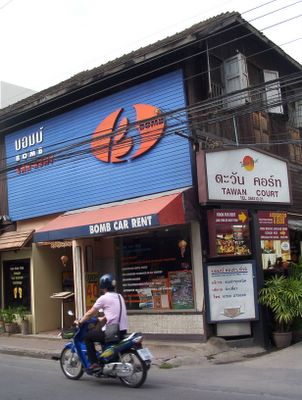
I picked up my glasses on Moonmuang (I just like saying Moonmuang…moon-moo-ang). The prescription was right, but for some reason they made me feel spacey and kinda dizzy. Fortunately, that went away in time, but it was pretty trippy for a while there. Dinner was delicious, I opted for some fish cakes and spring rolls, then we partied the night away in the Moonmuang area along the moat (moon-moo-ang).
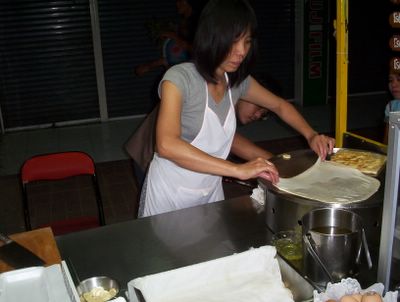
Mike and Rachel bought “rotis” at a street vendor stand. I was still full from dinner and they sounded a little strange – the most popular kind is a grilled crepe with bananas and egg wrapped inside and chocolate and condensed milk (straight out of the can and all syrupy-like) drizzled on top – so I opted out. I regretted it, though, Rachel gave me a taste of hers and it was amazing. Like a chocolate-y, banana-y French cruller. We spent most of the night at Cheers (everybody knew our name…beer name, at least, after the fourth round or so).
Oh yeah, and more Thais unclear on the concept.

The next morning, the tour company picked us up at our guesthouse and we were off to Doi Inthanon! As I said before, there are a number of different kinds of treks, and this one was one of the less-involved types. It was basically a bus tour in a mini-van with a group of about 12 people. But it was one of the only ways for us to get to the park, which was hour’s drive from Chiang Mai, and it was a good way to see the best parts in a short period of time.
Doi Inthanon is famous for being the highest mountain in Thailand at 2,565 meters. The park itself is fairly large and is a big destination for bird watching. It also has a number of religious sites and Hill Tribe villages, so we were getting quite a mix of stuff over the course of the day.
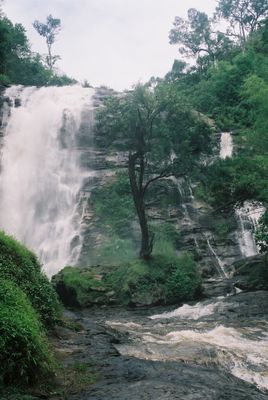
First stop was a waterfall, and it was amazing. The pictures say it all. We climbed on some of the rocks and followed the trail around to its base. But all too soon…back in the bus!

Second stop….was another waterfall! And this one was even bigger than the last. And just as spectacular. We played around for a while with these giant seed helicopter thingees that the maple seeds back home seem pretty pathetic. We had even less time here…and then back on the bus!
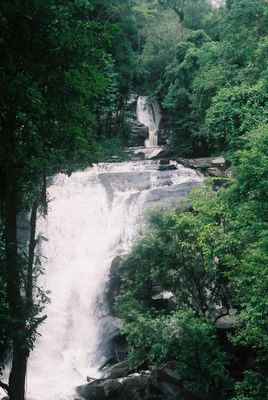
Third stop was a Karen village. The Karen Hill Tribe is a much larger group in Burma, and better known, but is still the largest and least-nomadic Hill Tribe group in Thailand. Traditionally, the Karen tribe is famous for their long-necked women (or “padaung”), who start lengthening their necks using brass rings at a very young age. But in the modern era, this practice has become problematic, both for health reasons (it weakens the neck) and because many of these Karen women have been placed into semi-slavery by unscrupulous tour companies who see them as a money-making attraction. Many Karen communities have abandoned the tradition as a result.

When we found out we were going to be participating this kind of voyeuristic visit, we got kinda nervous. It wasn’t on the pamphlet at the tour company – in fact, we chose that one on particular because it didn’t involve any Hill Tribes. As it turned out though, it was a quick stop, and involved very little pointing-n-staring, and no padaung women. We saw a quick weaving demonstration, admired some belts made out of watermelon seeds (thousands of them, they must really like their watermelon), walked the village, and then back on the bus! At this point, I started to feel a bit like we were being herded like cattle.
We had lunch at an open-sided thatched restaurant across from the village. Our timing couldn’t have been better, because it started to seriously pour moments after we got under shelter (the first real rain of the trip). I was a little annoyed at the German couple who were with us, who picked all of the meat out of the dishes and then had the gall to pour most of the sauce over their rice. It was all they ate. My meal was virtually meat and sauce-free as a result. One of the risks when you don’t take a private tour, I guess. Back on the bus!
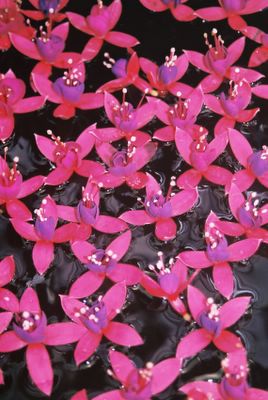
After lunch, we found ourselves at a commercial flower plantation project on the steppes of Doi Inthanon. Once upon a time, Thailand was notorious for its opium farms. Of course, for more reasons than I can count, the Thai authorities saw this as a bad thing. The current Queen of Thailand actually took direct responsibility for cleansing the country of the drug industry and has had a great deal of success in doing so (although, in some cases there were hurtful side effects of the project, which I won’t go into in more detail). Flower plantation farming was one of the new industries that were offered as a substitute, trading poppies for other species and creating markets for the new crops in Bangkok and other centers. Orchids are particularly popular, and we saw lots of them there. We toured some of the greenhouses housing millions of flowers and other plants under plastic sheeting, 20 seconds to look at the swans, and then…yes, back on the bus.

Next stop was the top of the mountain, which was promised to be one of the most spectacular views in Thailand. Of course, the rain clouds from lunchtime were still hanging around and we saw squat. About 5 seconds of staring at the blank grayness was enough for us. We took a walk through the lush forest at the top of the mountain along a boardwalk, admiring some colourful birds and beetles along the way. I rebelled a bit at this point and purposely came back to the bus late. I’m not sure that anyone noticed.
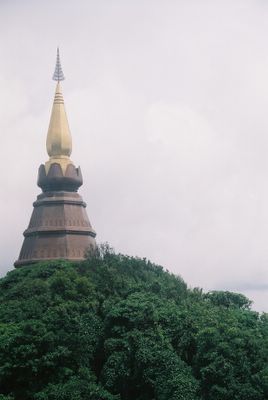
The last stop was kinda neat. Close to the top of the mountain are the twin pagodas of Phra That Naphamataneedon (say that fast, I dare you). The whole complex was started in 1987 when the Royal Thai Air Force built a chedi to celebrate King Bhumibol’s 60th birthday. Then in 1992, they followed suite with another chedi in honor of the Queen’s 60th.
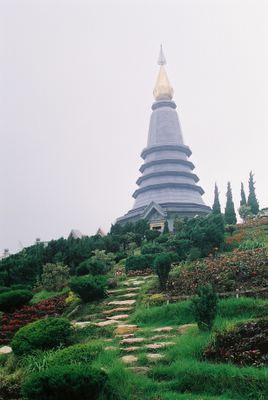
Unlike the top of the mountain, the view was quite a bit clearer here. And it was interesting seeing a modern take on a religious building to compare with all of the ancient ones we’d been seeing. The friezes along the sides of the buildings were incredible. The gardens were pretty ornate and extensive, too. All too soon, we were smushed into the bus and carted back to Chiang Mai. I’ve gotta say though, the whole thing felt rushed. I wish I had time to explore at least one of the trails through the forest, but it just wasn’t in the cards.

We checked into our rooms at the Souvenir guesthouse, which was much nicer than the place we were at the previous nights. The rooms themselves weren’t any better, but at least it had a nice garden courtyard and it was closer to where we wanted to go that evening.
We had dinner at a nearby restaurant and tried what turned out to be my favourite dish of the whole trip, Chiang Mai noodles with chicken. If you ever find this at a Thai restaurant, get it. It was soft noodles in a brown broth-y sauce with hard fried noodles on top. Delicious. It was so good that we barely noticed the dead goldfish that were floating upside down in the tank across from our table. An Irish couple at the restaurant talked us into checking out the Muay Thai boxing match that evening, which we had been debating for most of the day.
If you ever get to Thailand, you absolutely must not miss a match of Muay Thai. Okay, so what is it? Basically, it’s kick-boxing, and it’s old, first documented in 1411. Boxers have the choice of hitting with their hands (in boxing gloves) or their feet. It’s pretty brutal, many boxers have been known to break bones in the ring and it’s pretty much a sure thing that at least one match of the night will result in blood being spilled. It’s also a highly ritualized sport, involving ceremonial bows (called a “wai cru”) and even a special dance before the match (the “ram muay”).
The whole experience was cool and surreal. We got to this giant arena around 9pm and the matches had already started. Like in North America, the ring was in the middle, with wooden bleachers on all 4 sides and a big area where people were standing and watching or sitting on folding chairs. First reactions: the place was crawling in farang (foreigners, remember?) with very few Thai people. Rachel explained that this was probably because the ticket price for the night was more than the average Thai person made in a whole week. Understandable, to be sure. This deal was for the tourists and the high-rollers alone.
Many of the boxers were pretty young (one pair looked like they were 12 years old) and some were international, with one guy from the UK, one from Congo, and another from Germany. Strangely, it was the kids who were more vicious, probably because they had more to prove in front of the farang. We took turns making our own money-free bets on the boxers. Not knowing anything about any one of them from average guy “x” on the street, all we could say was “I’ve got red shorts! He looks feisty!” I think Rachel ended up with the keenest eye for picking the winners.
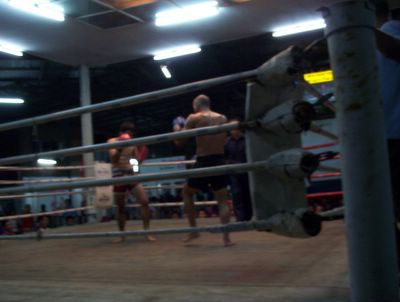
So through the match, people were placing bets and drinking beers in the stands. Every time a boxer made a nice hit, everyone around the ring shouted “OI!” And in the background was the most indescribable music imaginable. The 3-person band (called a “piphat” band) was live, and was made up of a drummer beating on a sideways bongo-like drum, a guy shaking tambourine-like jangly things, and a guy playing what looked like a clarinet. It sure didn’t sound like a clarinet though.
To our untrained western ears, there was no clear tune. I swear the “clarinet” guy was making the whole thing up as he went. The sound was equal parts screechy and squawky and basically sounded like a very, very loud impression of a complete amateur picking up a saxophone and randomly hitting keys and squeaking the reed to get some laughs. It wasn’t funny. It sounded terrible. I classified it as “the worst mood music I’d ever heard” on the spot. I’m sure they were very talented though. Hard to say without a frame of reference.
To make matters worse, once they reached the last few minutes of the 5th and final round of the match, they started to play faster and louder. If there’s a musical hell, I swear that a piphat band would be playing there. And unlike in North America, they only played when people were boxing. In between rounds, there was silence.
We left a bit early and made our way back across the Ping River. We closed out the night at the outer space-themed Bubble Disco (pronounced “bubbin” for some reason) where we drank our faces off, paid too much for drinks, made asses of ourselves dancing on speakers, dodged the US soldiers on the dance floor, and hit on/got hit on by some cuties. Fun had by all.
So that was Chiang Mai! Next stop, Part 7: “Intestinal Fortitude, See-Thru Airports, and Stinging Water”.


1 Comments:
My condolences...was piphat the reason why you stopped boxing? ;)
Post a Comment
<< Home